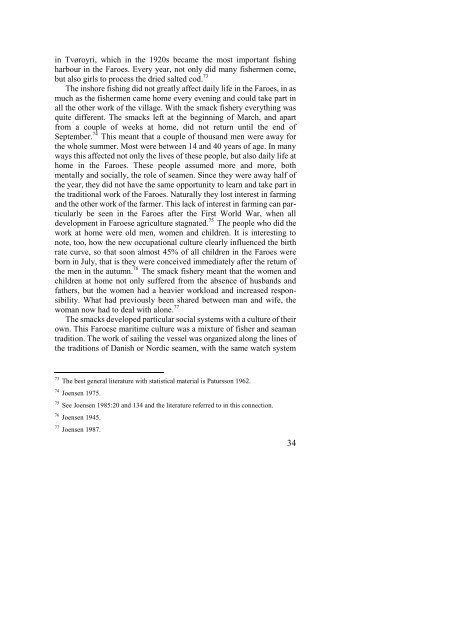The North Atlantic Fisheries, 1100-1976 - University of Hull
The North Atlantic Fisheries, 1100-1976 - University of Hull
The North Atlantic Fisheries, 1100-1976 - University of Hull
Create successful ePaper yourself
Turn your PDF publications into a flip-book with our unique Google optimized e-Paper software.
in Tvøroyri, which in the 1920s became the most important fishing<br />
harbour in the Faroes. Every year, not only did many fishermen come,<br />
but also girls to process the dried salted cod. 73<br />
<strong>The</strong> inshore fishing did not greatly affect daily life in the Faroes, in as<br />
much as the fishermen came home every evening and could take part in<br />
all the other work <strong>of</strong> the village. With the smack fishery everything was<br />
quite different. <strong>The</strong> smacks left at the beginning <strong>of</strong> March, and apart<br />
from a couple <strong>of</strong> weeks at home, did not return until the end <strong>of</strong><br />
September. 74 This meant that a couple <strong>of</strong> thousand men were away for<br />
the whole summer. Most were between 14 and 40 years <strong>of</strong> age. In many<br />
ways this affected not only the lives <strong>of</strong> these people, but also daily life at<br />
home in the Faroes. <strong>The</strong>se people assumed more and more, both<br />
mentally and socially, the role <strong>of</strong> seamen. Since they were away half <strong>of</strong><br />
the year, they did not have the same opportunity to learn and take part in<br />
the traditional work <strong>of</strong> the Faroes. Naturally they lost interest in farming<br />
and the other work <strong>of</strong> the farmer. This lack <strong>of</strong> interest in farming can particularly<br />
be seen in the Faroes after the First World War, when all<br />
development in Faroese agriculture stagnated. 75 <strong>The</strong> people who did the<br />
work at home were old men, women and children. It is interesting to<br />
note, too, how the new occupational culture clearly influenced the birth<br />
rate curve, so that soon almost 45% <strong>of</strong> all children in the Faroes were<br />
born in July, that is they were conceived immediately after the return <strong>of</strong><br />
the men in the autumn. 76 <strong>The</strong> smack fishery meant that the women and<br />
children at home not only suffered from the absence <strong>of</strong> husbands and<br />
fathers, but the women had a heavier workload and increased responsibility.<br />
What had previously been shared between man and wife, the<br />
woman now had to deal with alone. 77<br />
<strong>The</strong> smacks developed particular social systems with a culture <strong>of</strong> their<br />
own. This Faroese maritime culture was a mixture <strong>of</strong> fisher and seaman<br />
tradition. <strong>The</strong> work <strong>of</strong> sailing the vessel was organized along the lines <strong>of</strong><br />
the traditions <strong>of</strong> Danish or Nordic seamen, with the same watch system<br />
73 <strong>The</strong> best general literature with statistical material is Patursson 1962.<br />
74 Joensen 1975.<br />
75 See Joensen 1985:20 and 134 and the literature referred to in this connection.<br />
76 Joensen 1945.<br />
77 Joensen 1987.<br />
34















